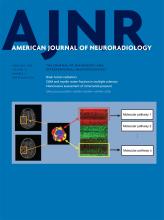Research ArticleAdult Brain
The CT Swirl Sign Is Associated with Hematoma Expansion in Intracerebral Hemorrhage
D. Ng, L. Churilov, P. Mitchell, R. Dowling and B. Yan
American Journal of Neuroradiology February 2018, 39 (2) 232-237; DOI: https://doi.org/10.3174/ajnr.A5465
D. Ng
aFrom the Department of Radiology (D.N., P.M., R.D., B.Y.)
L. Churilov
cStatistics and Decision Analysis (L.C.), Florey Institute of Neuroscience and Mental Health, Heidelberg, Victoria, Australia.
P. Mitchell
aFrom the Department of Radiology (D.N., P.M., R.D., B.Y.)
R. Dowling
aFrom the Department of Radiology (D.N., P.M., R.D., B.Y.)
B. Yan
aFrom the Department of Radiology (D.N., P.M., R.D., B.Y.)
bMelbourne Brain Centre (B.Y.), University of Melbourne, Royal Melbourne Hospital, Parkville, Victoria, Australia

References
- 1.↵
- 2.↵
- 3.↵
- Hemphill JC 3rd.,
- Bonovich DC,
- Besmertis L, et al
- 4.↵
- 5.↵
- Davis SM,
- Broderick J,
- Hennerici M, et al
- 6.↵
- Brott T,
- Broderick J,
- Kothari R, et al
- 7.↵
- Edavettal M,
- Rogers A,
- Rogers F, et al
- 8.↵
- 9.↵
- Hill MD,
- Muir KW
- 10.↵
- Gladstone D
- 11.↵
- 12.↵
- Huynh TJ,
- Demchuk AM,
- Dowlatshahi D, et al
- 13.↵
- Demchuk AM,
- Dowlatshahi D,
- Rodriguez-Luna D, et al
- 14.↵
- Delgado Almandoz JE,
- Yoo AJ,
- Stone MJ, et al
- 15.↵
- Rost NS,
- Smith EE,
- Chang Y, et al
- 16.↵
- Broderick JP,
- Diringer MN,
- Hill MD, et al
- 17.↵
- Godoy DA,
- Piñero G,
- Di Napoli M
- 18.↵
- Leys D,
- Cordonnier C,
- Debette S, et al
- 19.↵
- Goldstein LB
- 20.↵
- Al-Nakshabandi NA
- 21.↵
- 22.↵
- 23.↵
- 24.↵
- Landis JR,
- Koch GG
- 25.↵
- Zimmerman RA,
- Bilaniuk LT
- 26.↵
- Greenberg J,
- Cohen WA,
- Cooper PR
- 27.↵
- Kim J,
- Smith A,
- Hemphill JC 3rd., et al
- 28.↵
In this issue
American Journal of Neuroradiology
Vol. 39, Issue 2
1 Feb 2018
Advertisement
D. Ng, L. Churilov, P. Mitchell, R. Dowling, B. Yan
The CT Swirl Sign Is Associated with Hematoma Expansion in Intracerebral Hemorrhage
American Journal of Neuroradiology Feb 2018, 39 (2) 232-237; DOI: 10.3174/ajnr.A5465
0 Responses
Jump to section
Related Articles
- No related articles found.
Cited By...
This article has not yet been cited by articles in journals that are participating in Crossref Cited-by Linking.
More in this TOC Section
Similar Articles
Advertisement











